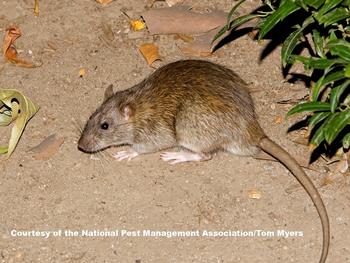
Cut back tree limbs within 3 feet of a roof to prevent roof rats from finding a nesting site in the upper portions of your building. Photo: Jack Kelly
Rats are a common, very annoying problem for gardeners. Rats damage garden crops and ornamental plantings, eat and contaminate food, damage structures and property, and transmit parasites and diseases. Norway rats, aka brown or sewer rats (Rattus norvegicus), and black rats, aka roof rats, ®. rattus) are the prevalent varieties that scurry in and around homes and other buildings, through farms, and in gardens and open fields.
Since rats are active all year, it is prudent to monitor periodically for their presence. Check for rat droppings around pet food containers and recycle bins. Rats are primarily active after dark - hearing rodent activity in your attic at night should raise concerns. Is there evidence of rodents feeding on fruit/nuts, or vegetables in your garden? All these and other indicators, such as rats running along utility wires or fences and finding evidence of their burrows/nests, are signs that it is time to initiate control measures.
A successful rat control strategy typically includes three elements: sanitation; building construction and rodent proofing; and, ultimately, population control. Collect garbage, trash, and garden debris frequently and ensure all garbage receptacles have tight-fitting covers. Thinning out dense vegetation can markedly reduce rat activity. If possible, plants such as ivy, star jasmine, and honeysuckle should be thinned or removed. Tree limbs within 3 feet of the roof should be cut back. Separate densely growing plants from each other and from buildings by a distance of 2 feet or more to make it more difficult for rats to scurry between them. Notably, if sanitation measures aren’t properly maintained, the benefits of other measures will be lost, and rats will quickly return.

Exclusion is the most successful and long-lasting form of rat control in structures. Photo: Kilessan
Exclusion is the most successful and long-lasting form of rat control in structures. Seal cracks and openings in building foundations and roofs along with openings for pipes, electric wires, drain spouts, and vents with coarse steel wool, wire screen, or lightweight sheet metal. To rodent-proof buildings, make sure no hole larger than 1/4 inch is left unsealed. Double-check to ensure doors, windows, and screens fit tightly.
Trapping is the safest and most effective method for controlling rats in and around homes. A simple wooden snap trap is more labor intensive but the least expensive option. Plastic single-kill rat traps cost more but are easier to set and clean. Finding the best locations to set traps is more critical than what type of trap is used.
Nutmeats, dried fruit, bacon, or a piece of kibbled pet food can be attractive baits for traps. Fasten the bait securely to the trigger of the trap with light string, thread, or fine wire so the rodent will spring the trap when attempting to remove the food. Glue can be used to secure the bait to the trigger. Soft baits such as peanut butter and cheese can be used, but rats sometimes can take soft baits without setting off the trap. Make sure the trigger is sensitive and will spring easily. If possible, avoid using rodent baits as they are toxic to dogs and cats. Keep pets away from dead or dying rodents.

Rats are active all year and are most active after dark. Photo: Tom Meyers
Areas with evidence of droppings, gnawing, and damage are typically the best places to set traps, especially when these areas are located between their shelter and food sources. To reduce the likelihood of “trap shyness,” leave traps baited but unset until the bait has been taken overnight and then reapply the bait & activate the trigger.
Use as many traps as possible so trapping time will be short and decisive. A dozen or more traps for a heavily infested home might be necessary. Place rat traps about 10 to 20 feet apart. Use disposable gloves to handle dead rodents. Dispose of dead rats by burying them or placing them in a sealed plastic bag and putting them in the trash.
If there is a continuous re-infestation from surrounding areas, consider hiring a licensed pest control applicator trained to use rodenticides safely.
 Cut back tree limbs within 3 feet of a roof to prevent roof rats from finding a nesting site in the upper portions of your building. Photo: Jack Kelly
Cut back tree limbs within 3 feet of a roof to prevent roof rats from finding a nesting site in the upper portions of your building. Photo: Jack Kelly Exclusion is the most successful and long-lasting form of rat control in structures. Photo: Kilessan
Exclusion is the most successful and long-lasting form of rat control in structures. Photo: Kilessan Rats are active all year and are most active after dark. Photo: Tom Meyers
Rats are active all year and are most active after dark. Photo: Tom Meyers


